![]()
![]()
![]()
Use LEFT and RIGHT arrow keys to navigate between flashcards;
Use UP and DOWN arrow keys to flip the card;
H to show hint;
A reads text to speech;
48 Cards in this Set
- Front
- Back
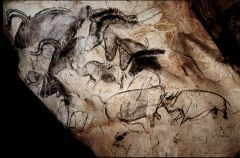
|
wall painting with horses, rhinos, and aurochs
culture: prehistoric Europe relative/absolute date: Paleolithic ancient context: Chauvet cave, France material: paint on limestone significance is in the act of creation. these paintings were important because they were clearly practiced and returned to by many over the following years. |
|
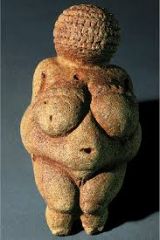
|
woman from willendorf culture: prehistoric Europe relative/absolute date: Paleolithic ancient context: Austria material: stone (limestone) very sexualized, with the sexual organs enlarged while she has no face and barely any arms or other noticeable body parts. expressed health and fertility. |
|

|
bird-headed man with bison culture: prehistoric Europe relative/absolute date: paleolithic ancient context: Lascaux cave, France material: paint on limestone it was the only painting in the cave that seemed to tell a story, and it was stylistically different from the rest. hunter with bird head is lying on the ground while a disemboweled bison is going to die. the man is merely a stick figure while the bison is illustrated with much detail. |
|
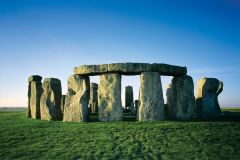
|
stonehenge
culture: prehistoric Europe relative/absolute date: neolithic ancient context: England material: stone megalithic monument. very complex, with 8 stages of construction. started as a cemetery for cremation burials and continued to be a domain of the dead. the use of bluestone was significant because it must have been transported over 150 miles from the west, telling us that those who designed it must have had ancestors in the west. migrants made a powerful connection with their homelands. we know that this was/is a burial site. |
|
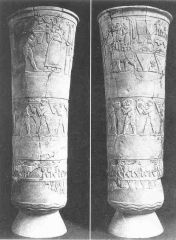
|
uruk vase
culture: Mesopotamia relative/absolute date: Sumerian, 4th millennium BCE ancient context: found in temple complex of Inanna material: alabaster tells a story, organized into three registers. lowest register shows life sources from the natural world (water, plants) with animals marching in a line. middle register shows naked men carrying baskets of goods. top register shows Inanna accepting an offering from two naked men in her shrine. the men are thought to be a priest and a ceremonially dressed priest-king. this depicted a marriage ritual that took place during the new year to ensure fertility of crops, animals, and people, and to continue the survival of Uruk. |
|
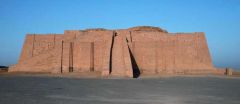
|
Nanna ziggurat
culture: Mesopotamia relative/absolute date: Sumerian ancient context: Ur material: mud-brick ordered to be built with King Urnammu. walls slope outward to prevent rainwater from puddling and eroding mud-brick. the first two levels are recent constructions. dedicated to the moon god Nanna. a ziggurat was a meeting point between earth and the heavens. this temple was a "stairway to heaven". it proclaimed wealth, prestige, and stability of the city's rulers. |
|
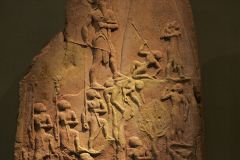
|
stele of Naram-Sin culture: Mesopotamia relative/absolute date: Akkadian ancient context: material: limestone depicts king Naram-Sin. the use of hierarchic scale shows his importance relative to other figures in the work. tells the story of one of his important military victories. hose to the left of him represent his army, and the others have been defeated and are begging for mercy. |
|
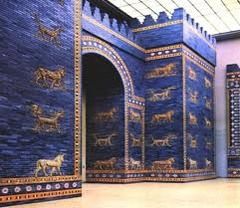
|
Ishtar Gate and throne room wall culture: Mesopotamia relative/absolute: Neo-Babylonian ancient context: Babylon material: glazed brick has four crenellated towers to symbolize babylonian power. walls were faced with dark blue bricks with gold lions that represented Ishtar lining the walls. |
|

|
Darius and Xerxes receiving tribute culture: Mesopotamia relative/absolute date: Persian empire ancient context: Persepolis material: stone Darius holds an audience while his son Xerxes listens from behind the throne. when freshly painted, we would see Darius's crown and necklace covered in gold leaf (sheets of hammered gold). |
|
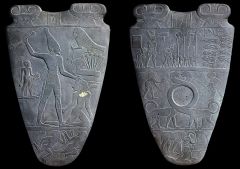
|
the Narmer palette culture: Egyptian relative/absolute date: Early Dynastic ancient context: material: stone represents the unification of Egypt and the beginning of the country's growth as a powerful nation-state. reverse side: hierarchic scale signals Narmer's importance, he is boldly represented as the focus of this work, wearing the white crown of Upper Egypt while striking an enemy. Horus (falcon) holds a severed head, on a block sprouting papyrus (symbolizing lower Egypt). this made the message clear: Narmer, ruler of upper Egypt, is in firm control of lower Egypt. most figures in this work are shown in composite poses. |
|

|
great pyramids culture: Egyptian relative/absolute date: Old Kingdom, 3rd millennium BCE ancient context: Giza material: limestone and granite not the first, but the most famous pyramid tombs at Giza. built by three 4th dynasty kings: Khufu, Khafre, and Menkaure. oldest and largest is Khufu's (13 acre base) |
|
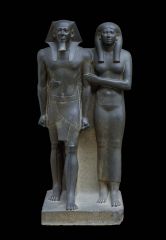
|
menkaure and a queen culture: Egyptian relative/absolute date: Old Kingdom ancient context: Giza material: stone bodies form a single unit together. very fit body types. in a symbolic gesture of embrace. conventional balanced pose with one foot forward. king's fists clenched around cylindrical objects. work was not completed, so the king may have died several years later. traces of red paint remain on the king, while traces of black paint remain on the queen's hair. |
|
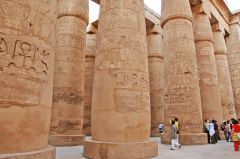
|
great temple of amun, including the hypostyle hall culture: Egyptian relative/absolute date: New Kingdom ancient context: Karnak material: stone the heart of the temple contained a statue of Amun. priests washed the statue every morning. also used the temple for religious festivals. hypostyle hall was used for royal coronation ceremonies. artists covered nearly every inch of the hall with painted pictorial reliefs and inscriptions. |
|

|
akhenaten and his family culture: Egyptian relative/absolute date: New Kingdom ancient context: Amarna material: limestone family sits laying with their children, who have elongated shaved heads. their bodies are less fit, much more androgenous. this has more of a relaxed vibe and conveys more love and emotion between the family than usual styles. the royal couple receives blessings of the Aten, whose rays offer ankhs before their nostrils, giving them the "breath of life". |
|

|
nefertiti culture: Egyptian relative/absolute date: New Kingdom ancient context: Amarna material: painted limestone a model for full sculptures of the queen. altered to bring the queen's face into conformity with contemporary notions of beauty. proportions are almost too ideal to be human. there is a dramatic use of color and her beauty strangely conforms with today's modern beauty standards. |
|
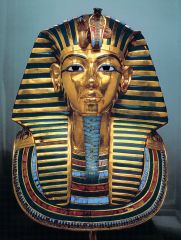
|
funerary mask of tutankhamun culture: Egyptian relative/absolute date: New Kingdom ancient context: material: gold, inlaid glass and semiprecious stones placed over head and shoulders of mummified body. found hidden very well in his tomb, to avoid robbers and looters. |
|
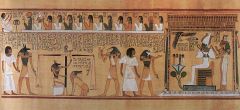
|
judgement before Osiris culture: Egyptian relative/absolute date: New Kingdom ancient context: book of the dead material: painted papyrus created for Hunefer and shows his three successive stages into the afterlife. Anubis leads him to where he will weigh his heart by the "feather of truth." Ma'at appears, and Ammit (eater of the dead) awaits results. Hunefer passes and is presented to throned Osiris. Hunefer is accepted into the afterlife. four small statues contain organs on a scale. |
|
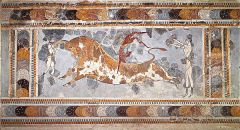
|
bull leaping culture: Aegean relative/absolute date: Minoan ancient context: Knossos, Crete material: fresco bull leaping was one of the most prominent subjects in Minoan art. the action represents an initiation or fertility ritual. pale (woman) at the right prepares to catch dark-skinned man in the midst of his leap, and the pale woman at the left grasps the bull's horns (perhaps about to jump herself). |
|

|
octopus flask culture: Aegean relative/absolute date: Minoan ancient context: Crete material: ceramic painter created a dynamic arrangement of marine life, seemingly to celebrate Minoan maritime powers. sea creatures float around on octopus's tangled tentacles. painter captures the grace and energy of natural forms while presenting them as a design in harmony with the vessel's shape. |
|
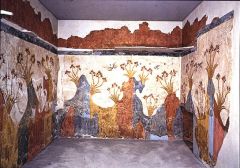
|
spring fresco culture: Aegean relative/absolute date: Minoan ancient context: Akrotiri material: fresco landscape of hills, rocks, and flowers; first pure landscape painting we've ever found in ancient art. work is very balanced and realistic. |
|
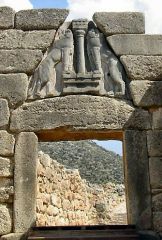
|
lion gate culture: Aegean relative/absolute date: Mycenaean ancient context: Mycenae material: stone "lion" beasts are genderless and almost unidentifiable. the lions are a metaphor for power, with a column resting between them. some suggest the column may symbolize a king or deity. |
|
|
absolute dating |
a precise historical date at which an object was made. more focused on years rather than relation to other works |
|
|
relative dating |
process of determining relative chronological relationships among excavated objects |
|
|
paleolithic |
means "old stone," hunter-gatherer cultures, |
|
|
neolithic |
"new stone," domesticated plants and animals, more permanent communities with food storage, some megalithic architecture |
|
|
post-and-lintel |
two columns with a platform on top. one method of megalithic architecture |
|
|
corbel vault |
layers of rocks piled up creating a round arch. one method of megalithic architecture |
|
|
megalithic architecture |
"large stone" |
|
|
hieratic scale |
using size to indicate importance of figures |
|
|
Inanna |
Sumerian goddess of fertility, love, and war |
|
|
Sumerian |
credited with important technological and cultural advances. they may have invented the wagon wheel and the plow. they also invented the first form of written script. |
|
|
cuneiform |
"wedge-shaped" symbols (Sumerian writing) used to keep business records |
|
|
votive figure |
statue forms of men and women dedicated to the gods. a form of communication/offerings to the gods. |
|
|
obverse |
the side bearing the principal design |
|
|
cylinder seal |
Sumerians redesigned the stamp seal as a cylinder. the cylinder left a raised mirror image of the design on a surface. individuals received seals as signs of status, and their seals were buried with them. |
|
|
stele |
Slab of stone usually used to commemorate something specific |
|
|
low relief |
sculpted relief with figures that project only slightly from a recessed background; not too deep of a contrast |
|
|
hieroglyph |
words and ideas in the form of pictorial symbols |
|
|
sarcophagus |
a stone coffin that was encased with gilt wooden shrines nested inside one another |
|
|
mastaba |
flat-topped, one story building with slanted walls erected over an underground burial chamber. |
|
|
necropolis |
a "city of the dead" at the edge of the desert on the west bank of the Nile. the land of the dead was believed to be in the direction of the setting sun. |
|
|
Imhotep |
planned Djoser's tomb, which turned into a step pyramid |
|
|
Rosetta Stone |
the key to deciphering Egyptian hieroglyphs |
|
|
Amarna |
physical depictions became distorted, changed, almost androgynous. facial features were distorted and exaggerated. less composed serenity and more emotions. |
|
|
repousse |
artists gently pushed up relief forms from the back of a thin sheet of gold hammering out a form from precious metal (usually gold) |
|
|
buon fresco |
painting on a still-wet plaster surface |
|
|
megaron |
the main hall of a Mycenaean palace or grand home |
|
|
faience |
type of ceramic covered with colorful opaque glazes that form a smooth, impermeable surface - first developed in ancient Egypt |

